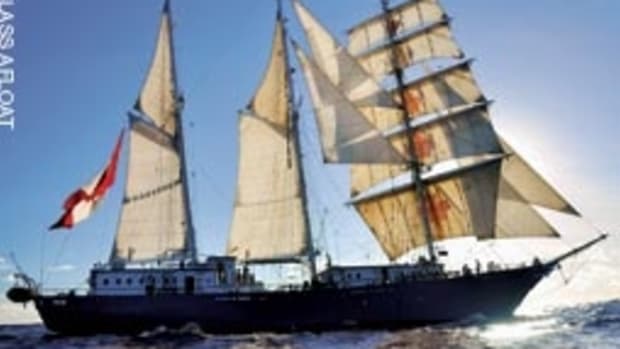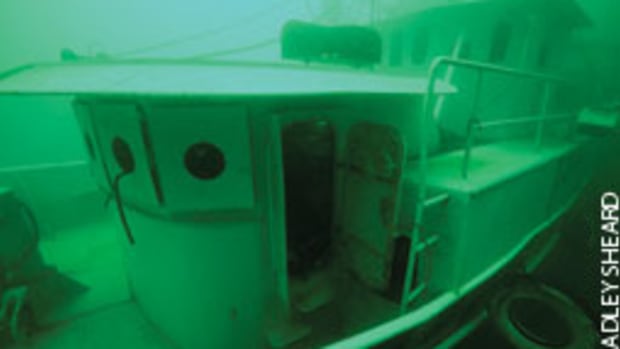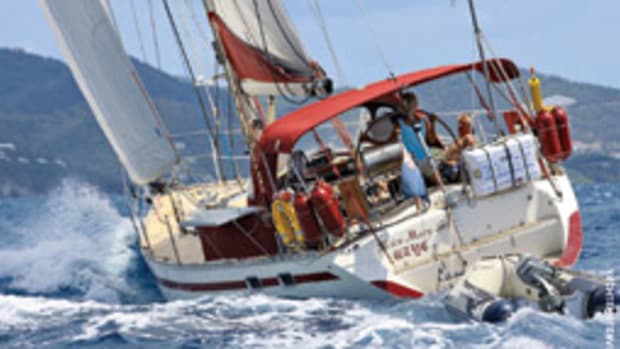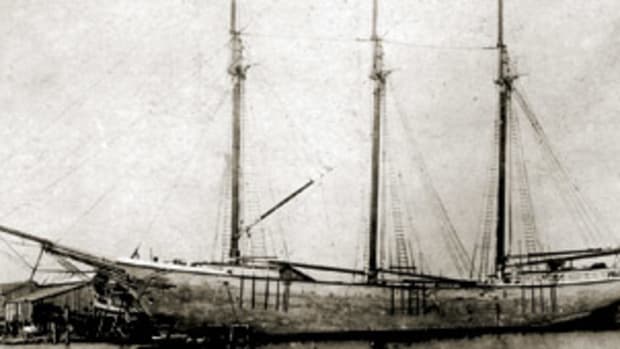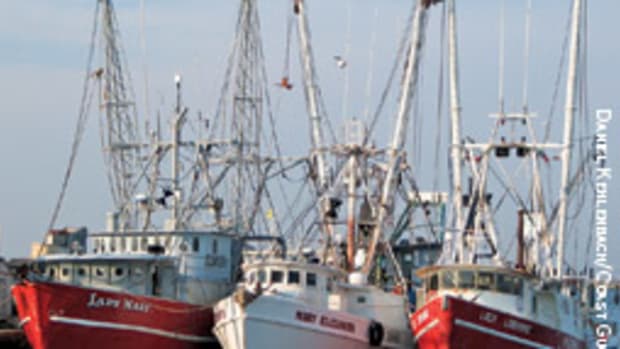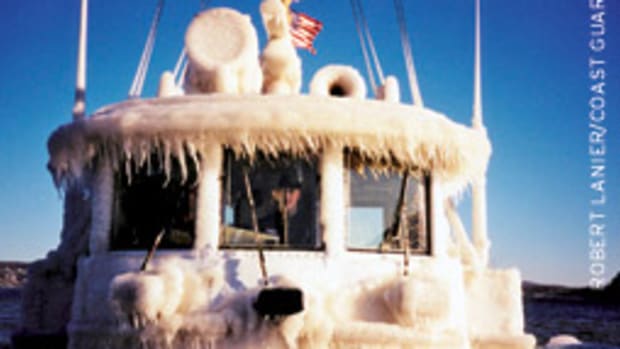Mystery: What sank the Lady Mary?
Divers find evidence that the scallop dredge may have been hit by a ship, but some think otherwise
Investigators still were trying to piece together the puzzle of why the Lady Mary sank, but divers have found evidence suggesting the fishing vessel might have gone down in a collision with a ship, a scenario all too common on busy sea lanes.
Lady Mary, a 71-foot scallop dredge, sank under mysterious circumstances early March 24 in the Elephant Trunk, a productive shellfish area 65 miles off the vessel’s home port of Cape May, N.J. Six of its seven crewmembers were lost. (The only survivor had been sleeping below and didn’t see what happened). One of the crewmembers managed to get off a hurried mayday, though it was barely discernible.
“It was short and screechy,” says Horatio Beck, skipper of the Good News 2, a 96-footer that was about six miles from Lady Mary that morning. Beck had just awakened and was having a cup of coffee about 5 a.m. The transmission was distorted, and the words tumbled out so fast, the voice shrill and hysterical. “I had to sit there and think, What did I just hear?”
He thinks now that he heard, “Mayday! Mayday! Coast Guard! Coast Guard!” But he wasn’t sure at the time. A skipper on another boat heard the call and asked who they were and where they were, but there was no answer. It was the last anyone heard from Lady Mary, and because no one on Lady Mary answered the fisherman’s query, those who heard the call judged it a hoax. “A lot of kids play with these things — on their dad’s yacht or on the docks,” Beck says.
Lady Mary’s crew had activated an EPIRB, but the beacon’s unique 15-digit identification code was incorrectly recorded in the National Oceanic and Atmospheric Administration’s database (see the July issue of Soundings or search the archives at www.SoundingsOnline.com — keyword: Lady Mary). When the EPIRB activated and sent its alert signal to a NOAA computer via satellite, the computer couldn’t find the EPIRB’s identifier code. It classified the beacon as “unregistered,” delaying the search.
The crew of Lady Mary got no help from that quarter, either.
There were probably 30 to 40 scallop dredges within an eight-mile radius of Lady Mary that morning, Beck says, and there were three ships in the vicinity: the Cap Beatrice, Energy Enterprise and APL Arabia. A Coast Guard Marine Board of Inquiry continues its investigation into the cause of the sinking, but six volunteer divers who went down three times to investigate, photograph and videotape Lady Mary for its owner, Smith & Smith Inc., of Bayboro, N.C., think they know what might have happened. They believe the evidence points to a ship collision similar to the one that disabled the fishing vessel Dictator 22 days later in the same waters around the same shipping lanes.
“If something did not hit the Lady Mary, I would be shocked,” says Harold Moyers, of West Chester, Pa., operator of the Cape May-based Big Mac dive boat and one of the dive team. He says the damage was very similar to that of Dictator and consistent with the below-the-waterline damage that a ship’s bulbous bow would cause if it hit Lady Mary’s stern ramp and running gear from the port side.
The divers’ findings:
• The stern ramp is crushed on the port side and its stanchions shoved through the steel hull into the lazarette.
• The rudder is broken off but still secured to the boat by a keeper chain. The shoe that holds the rudder in place is also broken off but missing, suggesting that it broke off while the boat was still afloat, not when it hit the bottom.
• The 5-inch-diameter stainless-steel prop shaft and bearing are bent down and forward, again suggesting that something crashed into them. Had the shaft bent when Lady Mary hit bottom, it would have been bent up.
• Two stay wires running from the gallis (or gallows) to corners of the stern ramp were broken. One of those, which ran through stainless-steel piping, had been tied off to the gallis to keep it from flailing about like a club, suggesting that it had broken while Lady Mary was on the surface and that the crew had tied it off while trying to recover from some catastrophic event.
• The dredge was stored on deck, right side up, still full of scallops, and the hook used to dump the dredge was stowed away. This suggests to Moyers that if there had been a collision and the boat was without power and wallowing in 12-foot seas with waves washing over the gunwales, the crew would have winched in the dredge, hoping to stabilize the boat.
• The 60-inch prop was pushed forward into the keel.
• Heavy steel strakes welded along the side of the rudder to stiffen it were bent like waffles, as if crushed.
• There was red bottom paint on the trailing edge of the blue rudder, and it wasn’t primer paint from the Lady Mary, which was beige. Moyers believes it is paint from the bottom of another vessel — a big one. On the third dive, he noted that the red paint was starting to disappear, suggesting that it is a soft ablative antifouling that dissolves in water over time.
Speculation swirls
Stevenson Weeks, the Beaufort, N.C., attorney representing Smith & Smith and family patriarch Royal “Fuzzy” Smith Sr., the Lady Mary’s shoreside manager who lost two sons and a brother in the sinking, says the Coast Guard has floated some competing theories for the vessel’s demise. One is that Lady Mary was inherently unstable and capsized. Weeks says finding the dredge upright on deck shoots down that theory.
Another is that the vessel listed severely in the seas, took water aboard and couldn’t shed the water fast enough because the scuppers were inadequate. He says that theory does not account for the damage to Lady Mary’s port quarter. There also had been talk about the damage resulting from a malfunction in the dredge as it was being winched in, but Moyers says the winch does not have the power to cause the kind of damage he saw on the Lady Mary.
Smith Sr. has advanced the theory that Cap Beatrice’s massive bow wake washed over the gunwales and through an open hatch into the cutting room, where the crew shuck the scallops. In this scenario, the electrical system shorts out in the flooding waters, and the vessel begins listing to port, leaving it unstable and vulnerable to further flooding in the 12-foot seas.
Attorney Weeks believes the Lady Mary did, in fact, suffer a severe list to port, but that it happened after some sort of collision with a large vessel — a “merchant ship.” He says the Cap Beatrice, a 728-foot Liberian-flagged container ship, was within 0.6 mile of where Lady Mary sank around the time the fishing vessel sent its mayday, according to transmissions from the ship’s Automatic Identification System, a collision-avoidance system that ships use to track each other. Coast Guard investigators interviewed the Cap Beatrice crew and sent divers to inspect its hull at dockside in Philadelphia. They found no evidence that the German-owned ship had been involved in a collision, but Weeks points out the inspection took place two months after the accident — after it had sailed to Australia and back.
Jim Taylor, mate on Elisa G, which was in the vicinity of Lady Mary when it sank, told a reporter three months later that about the time Lady Mary went down he saw a container ship stop dead in the water and turn on its lights — a very unusual occurrence, Weeks says, and if true, more grist for the collision theory.
“It’s a difficult case to prove cause,” he says. “We may be able to show there was a collision. We may not be able to identify the vessel that collided with Lady Mary.”
Weeks has his own theory. Lady Mary was laid-to with its dredge out, a common practice among commercial fishermen. “They were using the dredge as an anchor,” he says. A ship ran into Lady Mary’s port quarter, sending a bow wave flooding over the fishing vessel’s gunwales. The crew pulled in the dredge and tried to make emergency repairs, tying the port stay wire to the gallis to get it out of their way. “But they kept taking on too much water,” Weeks theorizes.
Their frantic efforts to keep the boat afloat, their efforts to call for help — the mayday and EPIRB activation — were for naught. Water from the bow wave, seas flooding in through the hole in the lazarette, and waves washing over the gunwales weighted it to port and ultimately sank it.
One crewmember, Jose Luis Arias, who had been sleeping below, survived the Lady Mary sinking. He made it into the water with his survival suit on and was rescued. Divers recovered Tarzon Smith’s body from the Lady Mary May 12. A few days later, a fishing boat found Frank Credle’s body in the water. Credle was found wearing boxer shorts, and Smith was wearing pajamas and no shoes, suggesting they also may have been asleep. The bodies of Royal Smith Jr. and Tim Smith were recovered earlier, on March 24. Both had survival suits on, but the suits appeared to have been hurriedly donned and were not fully buttoned up. Their faces were exposed, and the zippers were open at the neck. Jorge Ramos and Frank Reyes remained missing.
Dictator’s collision
Weeks points out the striking similarity in the damage on Lady Mary and Dictator. The 965-foot British-flagged container ship Florida collided with F/V Dictator April 14 about 47 miles off Cape May, causing $400,000 in damage to the 85-footer’s keel, rudder, prop, Kortz nozzle, shaft and engine (the collision knocked the engine off its bed), says Dictator owner Tim Harper of Southwest Harbor, Maine. Like the Lady Mary, a crewmember below on Dictator slept through the collision. The ship’s enormous bow wake swept over its deck. Florida kept going, evidently unaware of the collision, until another fishing boat radioed the ship what had happened.
“My boat put out a mayday, and [Florida] didn’t respond to it,” Harper says.
Harper says Florida was running at 18 knots through a fleet of 50 scallop dredges scattered within a 6-mile radius of Dictator in rain and fog with visibility a half-mile when the ship’s submerged bulbous bow clipped Dictator’s rudder and keel. “If the [helmsman] hadn’t seen the ship coming, they’d all be dead,” Harper says.
He saw the enormous hull looming, but Dictator’s dredge was deployed, limiting maneuverability. He cut hard to port and “got out of the way best he could, but it wasn’t enough,” Harper says. The crew put out a mayday. Nearby boats came to their aid, as did the Coast Guard, which towed Dictator into Delaware Bay. Though one of the crew broke four ribs and others were cut and bruised, the seven crewmembers and single fisheries observer survived the encounter.
There was no question Florida had been involved in the collision. Investigators later found three holes in Florida’s bulbous bow and a piece of Dictator’s Kortz nozzle inside. There may not be that kind of smoking gun in the Lady Mary case, but judging from the damage Harper has seen in photos and video of the wreck, he says he believes a ship hit Lady Mary. “I’d be real surprised if they could prove otherwise,” he says.
“There’s a lot of speculation out there” about what happened, says petty officer Christopher McLaughlin, a Coast Guard spokesman. The Marine Board of Investigation has found “no evidence” that the Cap Beatrice was involved in Lady Mary’s sinking, but it hasn’t taken the possibility of some sort of collision off the table, he says.
Investigators want to send another dive team down on the Lady Mary to bring the rudder, prop and prop shaft up for the National Transportation Safety Board to analyze, Weeks says. He’d also like them to cut out an aft section of the keel to see if the weld between the rudder shoe and keel was rusted or still was sound when the rudder and shoe broke off. Weeks expects the board to resume hearings in August or September.
Meanwhile, Dictator owner Harper is advocating for rules that would keep ships out of regulated fishing grounds during seasons when the waters are thick with fishing boats. Anywhere from 50 to 150 scallopers can be fishing the 40-by-40-mile Elephant Trunk on a day in March or April, catching what they can before the fleet reaches its catch limit and the waters are closed for the season.
“These freighters are going right down through there at 20 knots,” he says. Ships can’t stop on a dime, and fishing vessel crews need time to haul in their dredges. If neither sees the other in time, it’s a recipe for disaster.
Harper has the ear of Maine Sen. Susan Collins. “We have to do this or more people are going to get killed,” he says.
See related article: "You shall, not should, keep a watch"
This article originally appeared in the September 2009 issue.

